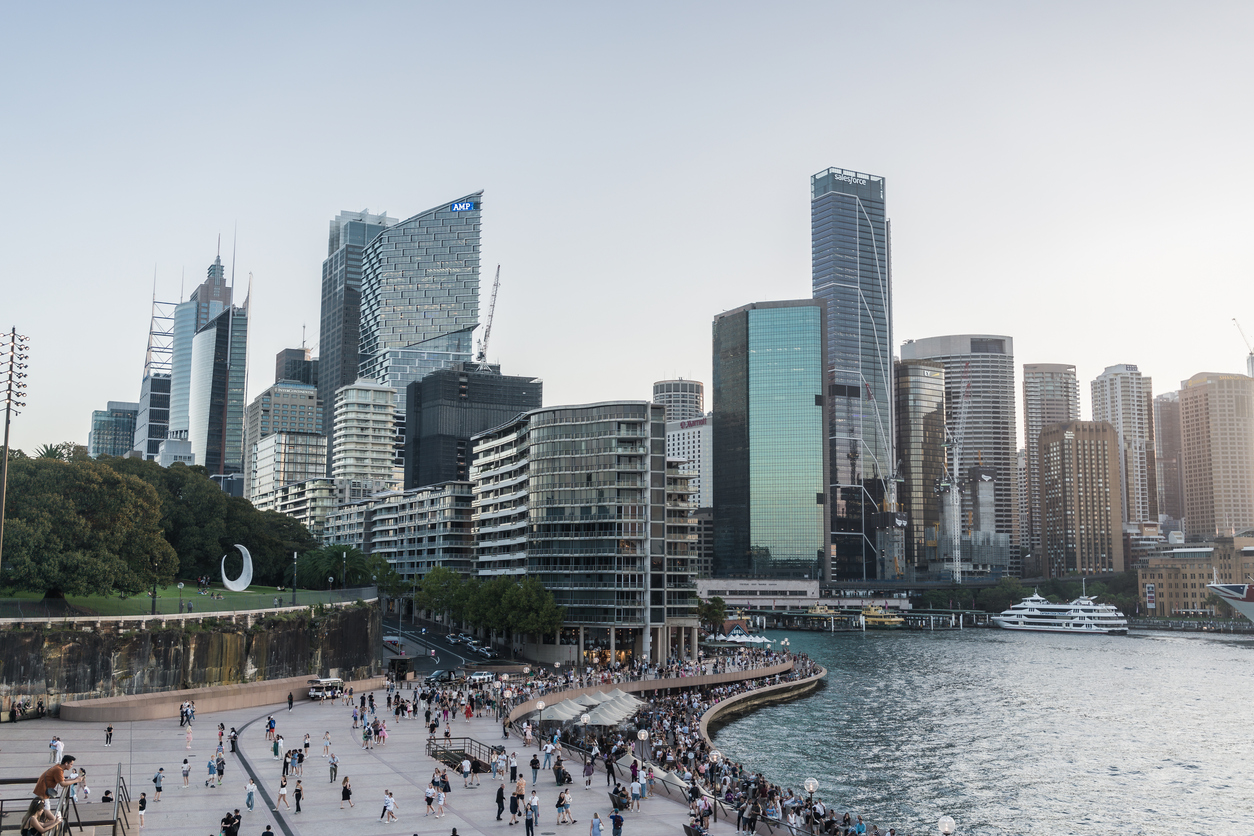Sydney's high-end real estate market is experiencing a significant surge, drawing global attention and reaffirming the city's status as a magnet for affluent investors. Despite economic headwinds—including three consecutive cash rate hikes by the Reserve Bank of Australia in 2024—demand for luxury properties has remained remarkably strong.
According to Knight Frank's Global Super-Prime Intelligence report, Sydney recorded 100 super-prime residential sales (valued at over USD 10 million) in 2024, totalling USD 1.586 billion. The average transaction was USD 15.9 million, cementing the city's position among the world's top luxury property markets.
This growth—despite rising interest rates—signals other driving forces at play, including investor confidence in Sydney's stability, lifestyle appeal, and long-term capital growth. Elite suburbs like Point Piper and Barangaroo command average prices of around AUD 12 million, with record-breaking sales illustrating the strength of demand.
This influx of capital and investor interest continues to reshape Sydney's most prestigious postcodes, reinforcing its global reputation as a premier luxury property destination.
The Unwavering Allure of Sydney's Prime Real Estate
The attraction of Sydney's prime real estate for high-net-worth individuals (HNWIs) is multifaceted, stemming from Australia's stable economy, an attractive lifestyle, and the inherent quality of the properties themselves. Even as the RBA has increased cash rates, the luxury segment appears to operate with a degree of insulation, driven by buyers less sensitive to interest rate fluctuations. Cotality's Home Value Index shows Australian home values nationally hit a new high in April, adding approximately AUD 2,720 to the median price of a home.
While Sydney's overall property values remain 1.1% below their September 2024 high, the luxury end of the market tells a different story, one of sustained demand and premium prices. This confidence is further bolstered by ongoing development, such as naming Sydney's newest luxury lifestyle precinct, The Lands by Capella. It is a 10,000-square-metre development set to open in Q1 2026, underscoring long-term investment in the city's luxury appeal.
Experts suggest that for many international HNWIs, Australian property, particularly in Sydney, represents a strategic diversification of their global portfolios. The city is perceived as a secure location for capital preservation, offering political stability and a transparent legal system. These factors are increasingly prized in an uncertain global landscape.
The lifestyle component, encompassing beautiful beaches, a vibrant cultural scene, and excellent educational institutions, adds another layer of appeal, making Sydney an investment destination and a desirable place to live or spend significant time. This sentiment is also reflected in the commercial sector, with values across Sydney CBD office towers showing their first price gain in three years in the March quarter, a modest 0.7% increase but significant as the first since early 2022. This suggests a broader recovery in sentiment for Sydney's prime real estate assets.
Record-Breaking Transactions: A Closer Look at Elite Buyer Activity
The heightened activity includes significant interest in land and redevelopment opportunities in affluent areas. For example, five homeowners in Rose Bay are collectively hoping for a windfall exceeding $40 million from developers by amalgamating their properties, a move spurred by new housing policies allowing mid-rise apartments near transport hubs. Paul Ephron of Colliers reported receiving 150 inquiries for this amalgamated site, indicating robust developer appetite. This mirrors findings from Ray White Group Chief Economist Nerida Conisbee, who noted that knockdown activity is concentrated in affluent suburbs. Melbourne tops the list (34,490 houses approved for demolition), followed by Sydney (32,578).
Further underscoring the unique dynamics of this market segment, a Sydney investor recently listed a dream beach house in South Coogee for $16 million, a property they purchased for $15.25 million in 2021 but never lived in. Such transactions highlight that for some elite buyers, properties are also seen as highly liquid assets or opportunities for significant capital appreciation, even over relatively short holding periods.
This contrasts with the broader Sydney market, where an API Magazine report found that three-quarters of suburbs within five kilometres of central Sydney experienced property price falls in the past year, while outer, more affordable areas saw gains. This bifurcation shows that the luxury market is following its own trends, driven by global wealth rather than local affordability constraints. Jason Simoes, Director at XS Property, identified several areas expected to benefit from future infrastructure investment, suggesting that strategic development continues to fuel value, particularly in premium locations.
Economic Ripples: Implications of the Luxury Boom
The surge in Sydney's luxury property market carries significant implications for the broader Australian economy. This influx of international capital contributes to economic activity through various channels, including increased transactional revenue like stamp duty and stimulating sectors such as high-end construction, interior design, and luxury retail.
The development of new luxury precincts marks "a defining moment in the development of the Sandstone Precinct as a world-class destination," generating employment and boosting tourism infrastructure. This investment confidence can have a positive spill-over effect on general market sentiment. However, it also raises concerns about affordability for the average citizen. Data from Cotality shows the national median dwelling value reached $825,349 in April, a figure significantly influenced by strong performances in major capital city luxury segments.
While the luxury boom injects dynamism into the economy, it also contributes to the widening gap in property wealth. While prime inner-city suburbs see record prices, many other parts of Sydney are experiencing different market conditions (for example, 81% of suburbs 20km or more from Sydney's GPO recorded annual gains, compared with only 26% of those within 5km), highlighting a divided market.
The concentration of wealth in luxury real estate can also push up land values in surrounding areas, potentially impacting commercial viability for some businesses and further straining affordability for residents. However, the overall property market outlook remains positive, with experts predicting property potential will continue growing into 2025, supported by strong fundamentals and ongoing buyer interest despite economic headwinds like federal election uncertainty, as noted in April.
Sophisticated Financial Strategies of the Elite
Acquiring multi-million dollar properties in a competitive market like Sydney often requires sophisticated financial strategies beyond conventional mortgages. High-net-worth individuals frequently employ complex financing structures, utilize wealth management services, and use existing global assets to facilitate these significant purchases. Speed and flexibility are often paramount, especially when unique or highly sought-after properties come onto the market.
These buyers might use private banking facilities, establish trusts or corporate entities for acquisition, or tap into bespoke lending solutions that cater to their specific financial circumstances and the often unique nature of luxury assets. Such strategies allow them to move quickly and decisively, securing properties others might acquire soon. Accessing substantial liquidity rapidly can be a significant advantage in negotiations for these top-tier assets.
Property is part of a diversified investment portfolio for many affluent buyers, and financing decisions are made within this broader context. They might seek to optimize their capital structure, balancing equity and debt to maximize returns or manage risk. In some instances, private lending and specialized financial instruments play a crucial role. For example, bridging finance or equity release from other properties can be vital.
"For high-net-worth individuals, speed and flexibility in financing can be paramount when securing unique property assets," observes a financial strategist. "Options like a second mortgage can provide swift access to capital, allowing buyers to act decisively in a competitive market. These instruments are often part of a broader strategy to optimize liquidity and manage large-scale investments effectively, particularly when dealing with multi-million dollar acquisitions." This approach highlights how such specialized lending options can be essential for HNWIs navigating large and complex property transactions, allowing them to unlock equity from one asset to secure another without disrupting existing primary financial arrangements.
Local High-Net-Worth Individuals Navigating a Competitive Landscape
The influx of international buyers into Sydney's luxury property market has intensified competition, prompting local high-net-worth individuals to adapt their strategies. While some local HNWIs might find themselves outbid on certain trophy assets, many are using their deep understanding of the market, established networks, and potentially quicker decision-making capabilities due to onshore presence.
They are also active in the "knockdown and rebuild" trend identified by Nerida Conisbee, where older homes in premium suburbs are acquired for their land value to develop new, bespoke luxury residences. This allows them to create properties tailored precisely to their preferences while capitalizing on the inherent value of prime locations. The Australian Bureau of Statistics shows significant demolition approvals in Sydney, pointing to this ongoing redevelopment cycle led by those with substantial capital.
Additionally, local HNWIs are often well-positioned to identify and invest in emerging luxury hotspots or properties with unique development potential that might be less obvious to international buyers. They may also engage in off-market transactions, relying on established relationships with real estate agents to access properties before they are publicly listed.
Despite the increased competition, the overall health of the Australian economy and the underlying desirability of Sydney real estate mean that local HNWIs continue to see value and opportunity. Perth's property market, for example, is also redefining 'premium' as prices surge, with 37 Perth suburbs joining the million-dollar club in 2024. This shows that strong domestic demand for high-end property is a national trend, not just confined to Sydney. This indicates a resilient domestic buyer base capable of participating actively, even in a globally competitive environment.
Sydney's Enduring Appeal in a Shifting Global Landscape
Sydney's luxury property market is demonstrating remarkable strength in 2024, with record-breaking sales and sustained international interest despite rising interest rates and global economic uncertainties. High-profile acquisitions are a testament to the city's status as a premier destination for global wealth. This boom is driven by a combination of factors, including Australia's economic stability, appealing lifestyle, and the strategic financial planning of elite buyers who see Sydney real estate as a secure and desirable asset class.
The implications of this activity are broad, contributing to economic growth and development while highlighting challenges related to housing affordability and market segmentation. Sophisticated financial strategies, including bespoke lending solutions, continue facilitating these large transactions. As new luxury developments come online, Sydney's allure seems set to endure. The ongoing dynamism, exemplified by trends like premium suburb knockdowns and strong developer interest in amalgamated sites, suggests that both international and local high-net-worth people will continue to shape the future of this vibrant and competitive market. The key question for the future will be how the benefits of this high-end boom can be balanced with the broader needs of the city and its residents.














